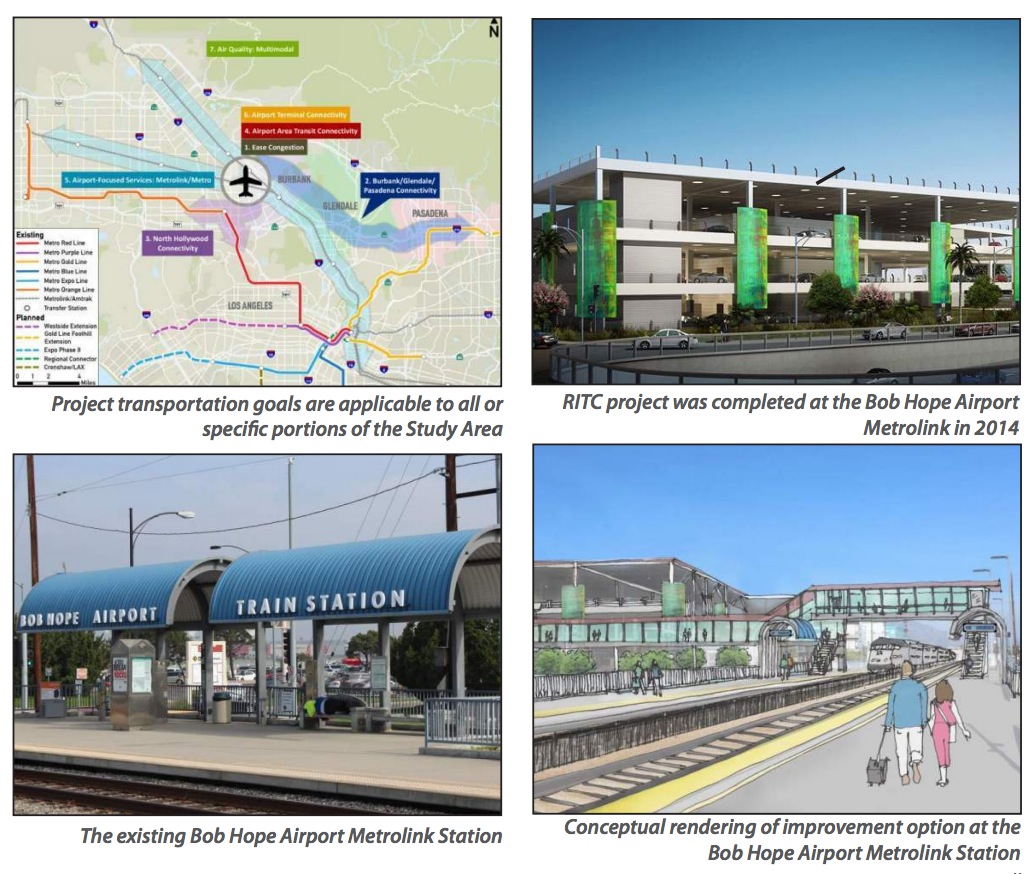CITY OF BURBANK
BOB HOPE AIRPORT
Executive Summary
The Burbank-Glendale-Pasadena Airport Authority (Authority), owner and operator of the Burbank Bob Hope Airport (Airport), and the City of Burbank, have established the Bob Hope Airport Multimodal Ground Access Planning Study (MGAPS), funded by the United States Department of Transportation, and Land Use Study, funded by the Los Angeles County Metropolitan Transportation Authority (Metro), to conduct two separate, but coordinated studies of transportation and land use development in the vicinity of Bob Hope Airport. The options presented in this report complement the transit oriented development (TOD) options presented in the Land Use Study.
The goal of MGAPS is to develop ground transportation improvements that will enable the Airport to serve as a multi-modal regional transportation hub. The separate Land Use Study is intended to identify TOD opportunities in the Airport area to take advantage of the Airport’s transportation connections and assist City Planners and Elected Officials in creating land use policy that will foster development near transit centers.
With the presence of the Burbank Bob Hope Airport, Metrolink/Amtrak regional rail lines, and Metro local transit service, this area of Burbank is well situated to become a hub for local and regional transportation that can support a planned effort to incorporate TOD opportunities. For this reason there is a strong case for introducing new transportation services and land use improvements that will support this co-location of the Airport and the surrounding transit options.
Feedback provided by stakeholders and the public during meetings indicates a strong consensus that the Study Area is well suited for improved transit connectivity and supporting land uses. The transportation goal for this project is:
Project Goal: Develop ground transportation improvements that will enable Bob Hope Airport to serve as a multi-modal regional transportation hub.
The Study Area is currently served by several major transit operators, including BurbankBus, Los Angeles County Metropolitan Transportation Authority (Metro), Metrolink, and Amtrak. But even with this service, there are still several large gaps in the Study Area’s transit network, most notably the lack of regional rail service during peak Airport employee and passenger travel times and no direct connection to the Metro subway, bus rapid transit (BRT) or light rail system. Due to this lack of service and connectivity to the larger system only two and seven percent of passengers and employees, respectively, use transit to access the Airport, respectively. The Airport presents an opportunity to improve transit ridership in the Study Area and region because it can act as a central hub for all transportation connections. From air, rail, subway, bus and private automobile the Airport is centrally located to be the epicenter for multi-modal connectivity for the San Fernando Valley.
This report identifies the existing deficiencies in the transportation system, defines key issues and objectives for the project, and outlines options to address the issues and meet the objectives. It then goes on to outline the alternatives, ranging from short-term/low cost to long-term/high cost, and discuss next steps and priorities.
The objectives for this project are:
- 1. Ease congestion on key Study Area roadways.
- 2. Enhance regional connectivity between Pasadena, Glendale and Bob Hope Airport.
- 3. Enhance regional connectivity between North Hollywood and Bob Hope Airport via Metro rail and local buses.
- 4. Improve intermodal transit connections in the Study Area.
- 5. Provide reliable, fast and convenient transit connections for Airport passengers and employees, especially via the Southern California Regional Rail Authority (Metrolink) corridors and Metro bus.
- 6. Improve transit connectivity in the Airport terminal area.
- 7. Improve air quality and reduce Greenhouse Gas (GHG) emissions in the Study Area.
Transportation improvement options were developed based on input from the Airport and City staff, stakeholder groups, and comments received from the public. The improvement options are grouped based on how they addressed specific project objectives as defined in this report.
This report focuses on developing specific alignments, potential station/stop locations, and/or implementation strategies for each of the transportation options. The package alternatives to meet each objective in- Conceptual rendering of improvement option at the Bob Hope Airport Metrolink Station RITC project was completed at the Bob Hope Airport Metrolink in 2014 The existing Bob Hope Airport Metrolink Station Project transportation goals are applicable to all or specific portions of the Study Area includes a short-term/low-cost alternative, mid-term/medium-cost alternative, mid-term/high-cost alternative, and a long-term/high-cost objective.
During the study effort, a number of strategic mobility projects have been initiated in the Airport area. These projects, in addition to those proposed in this study, will help achieve the over all project goal.
About the City of Burbank
www.burbankca.gov
Throughout its 100 year history, Burbank has embodied a forward-thinking city that provides a high quality of life and strong sense of community to its residents. In keeping with this tradition, the City will continue to combine 21st century technology with the same small town feel that will make Burbank an ideal place to live, work and play for years to come.
About Bob Hope Airport
bobhopeairport.com
The Burbank-Glendale-Pasadena Airport Authority is a separate government agency created under a joint powers agreement between the three cities of Burbank, Glendale and Pasadena in 1977 for the sole purpose of owning and operating the Bob Hope Airport.
Tags: Airport, Bob Hope Airport, Burbank, CA, California, City of Burbank, Los Angeles, Los Angeles Metro, Metro







 RSS Feed
RSS Feed